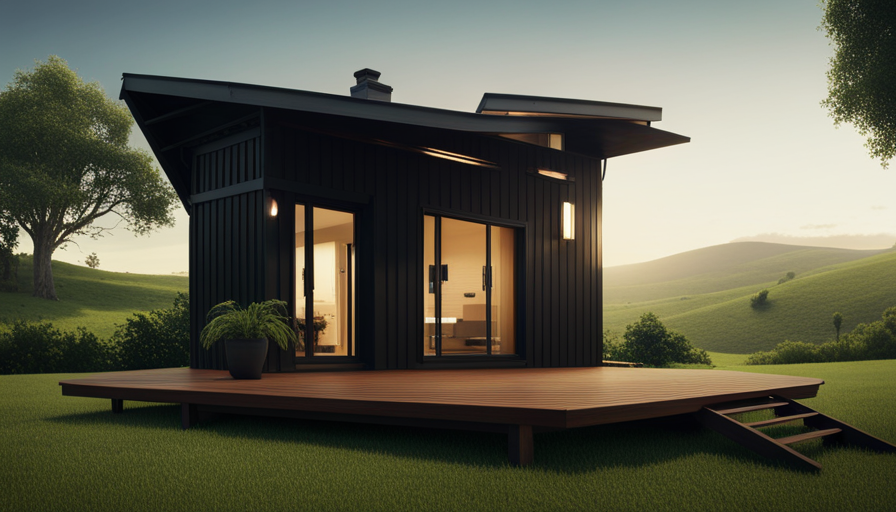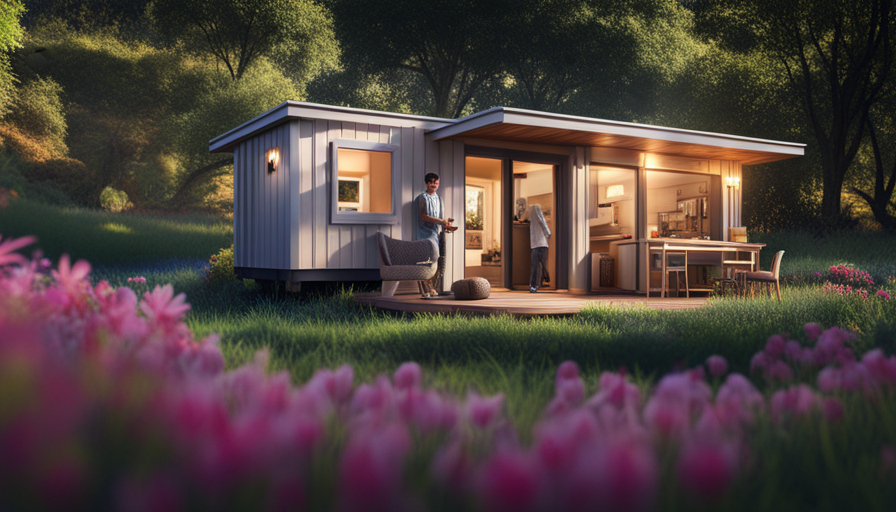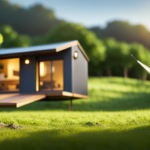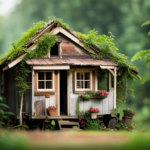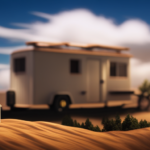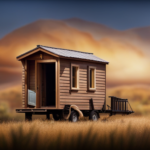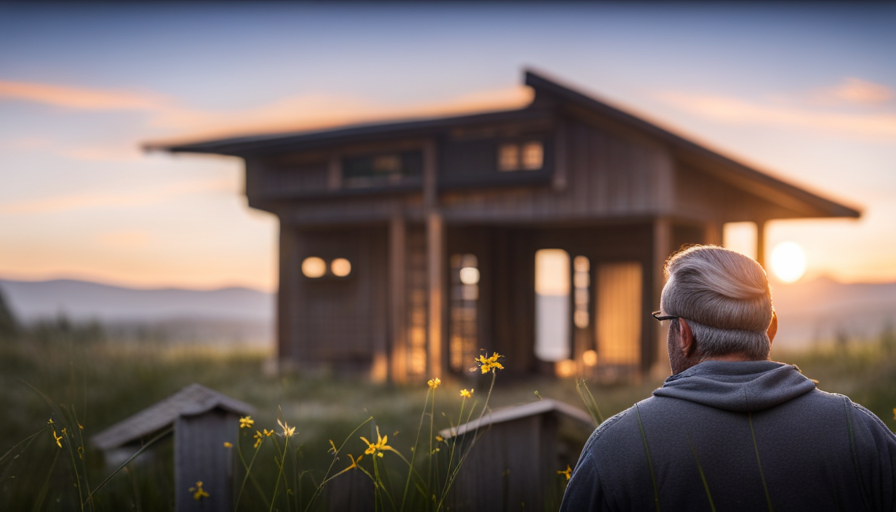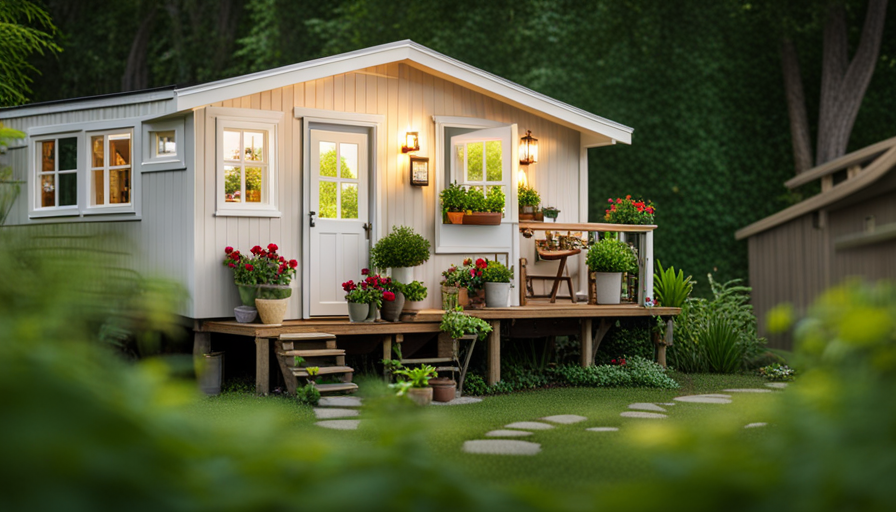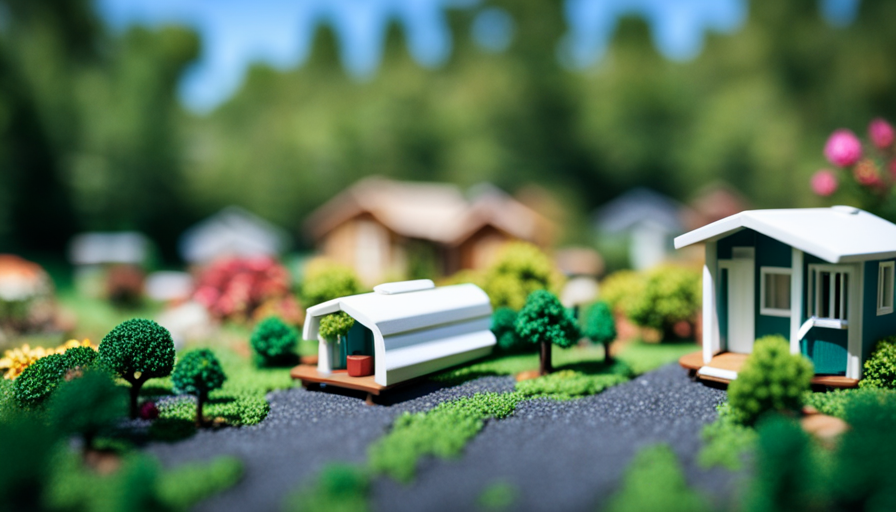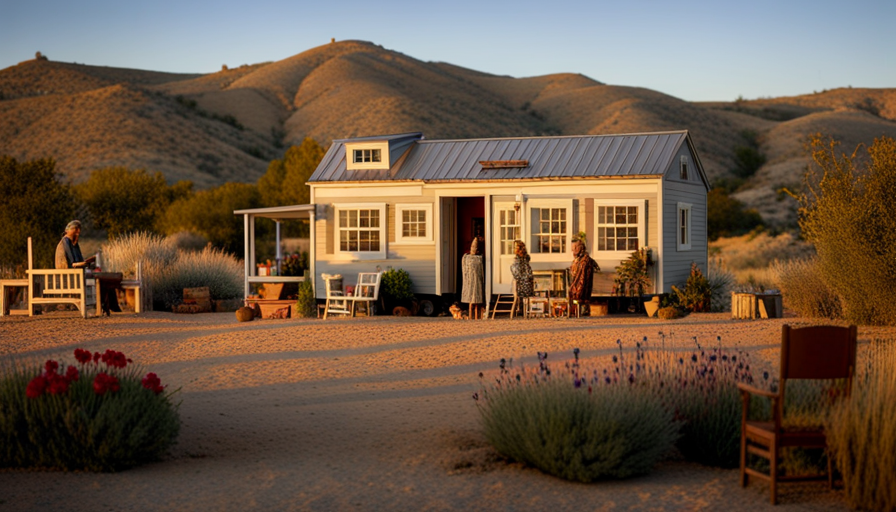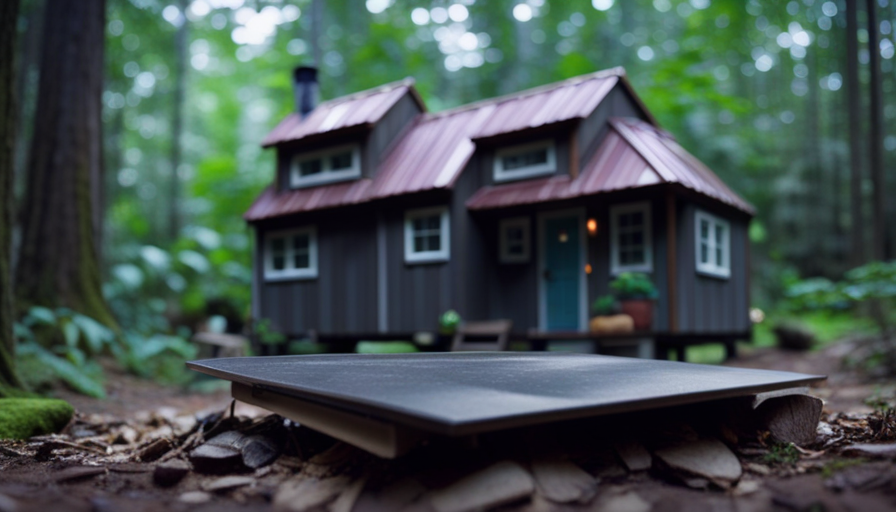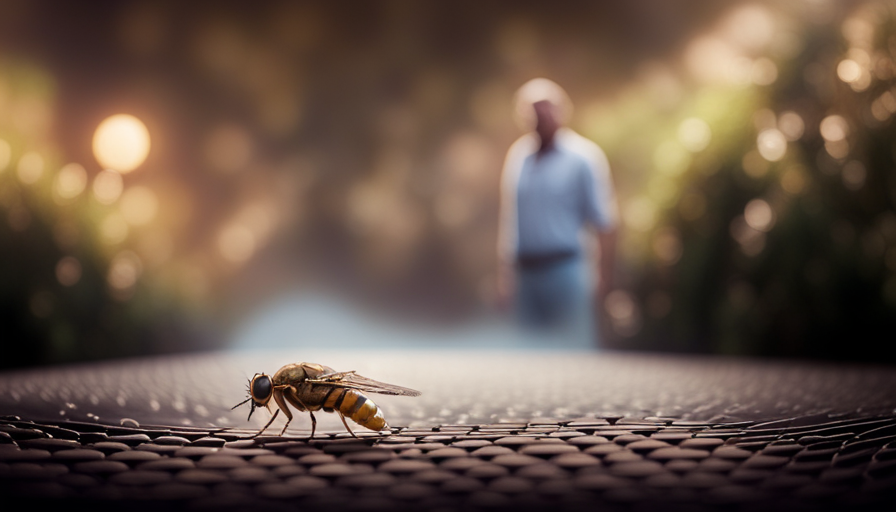Were you aware that the life expectancy of a tiny house surpasses that of a standard home? Recent research indicates that tiny houses typically last between 30 to 50 years, while traditional homes have a lifespan of 25 to 30 years.
This intriguing statistic highlights the durability and longevity of these unique dwellings. In this article, I will explore the factors that contribute to the lifespan of a tiny house, including:
- Construction materials and techniques
- Regular maintenance and repairs
- Climate and weather conditions
- Quality of workmanship
- Foundation and structural integrity
- Lifestyle and frequency of use
- Adaptability and upgradability
- Insurance and legal considerations
By understanding the various elements that influence the longevity of a tiny house, you can make informed decisions when designing, building, and maintaining your own tiny home.
So, let’s dive in and explore the fascinating world of how long a tiny house can last.
Key Takeaways
- The average lifespan of a tiny house is typically longer than that of a traditional home, ranging from 30 to 50 years.
- Factors such as construction materials, techniques, regular maintenance, climate, and quality of workmanship significantly impact the lifespan of a tiny house.
- Sustainable and eco-friendly construction materials and techniques are crucial for both durability and environmental responsibility.
- Maximizing storage space and incorporating energy-efficient appliances and fixtures are important considerations in the design of a tiny house.
Construction Materials and Techniques
The use of sustainable and eco-friendly construction materials and techniques is essential in creating a tiny house that’s not only compact and efficient but also environmentally responsible.
When it comes to constructing a tiny house, there are various construction methods and interior design choices that can be made to ensure that the house is not only aesthetically pleasing but also durable and energy-efficient.
One popular construction method for tiny houses is using recycled materials. This not only reduces waste but also lowers the overall cost of construction. Additionally, using renewable resources such as bamboo or reclaimed wood for flooring and cabinetry not only adds a unique touch to the interior design but also minimizes the environmental impact.
In terms of interior design, maximizing storage space is crucial in a tiny house. Utilizing built-in storage solutions, such as hidden compartments or multipurpose furniture, can make the most out of limited square footage. Furthermore, incorporating energy-efficient appliances and fixtures, such as low-flow toilets and LED lighting, can significantly reduce energy consumption and utility costs.
Transitioning into the subsequent section about regular maintenance and repairs, it’s important to note that proper construction materials and techniques can also make a significant impact on the longevity and durability of a tiny house.
Regular Maintenance and Repairs
To properly maintain and repair your compact dwelling, it’s crucial to regularly address any necessary upkeep tasks. By following a maintenance schedule, you can ensure that your tiny house remains in good condition and avoid costly repairs in the long run. Regular tasks such as cleaning the exterior, checking for leaks, and inspecting the electrical and plumbing systems should be included in your maintenance routine.
In addition to regular maintenance, it’s important to be prepared for unexpected repairs. While tiny houses are generally more affordable to maintain compared to traditional homes, the cost of repairs can still vary depending on the extent of the damage and the materials used in construction. It’s advisable to set aside a portion of your budget for potential repairs and have a contingency plan in case any major issues arise.
To emphasize the importance of regular maintenance, here is a table showcasing the potential cost of repairs based on different scenarios:
| Repair Type | Cost Range |
|---|---|
| Roof Leak | $200 – $1000 |
| Plumbing Issue | $100 – $500 |
| Electrical Problem | $150 – $800 |
By staying on top of maintenance tasks and being prepared for repairs, you can ensure that your tiny house remains a comfortable and safe living space. Transitioning into the next section about climate and weather conditions, it’s important to consider how these factors can impact the maintenance and repairs required for your compact dwelling.
Climate and Weather Conditions
Properly maintaining and repairing a compact dwelling necessitates addressing climate and weather conditions to ensure its longevity and functionality.
Weather patterns play a significant role in the overall performance of a tiny house, especially when it comes to heating and cooling. Understanding the local climate and its impact on the house’s temperature regulation is crucial for creating a comfortable living environment.
Extreme weather conditions, such as hot summers or cold winters, can put a strain on the heating and cooling systems of a tiny house. In regions with scorching summers, adequate insulation and ventilation are essential to prevent the interior from becoming unbearably hot. On the other hand, in colder areas, proper insulation and efficient heating systems are crucial to keep the house warm and cozy during winter months.
Moreover, weather patterns can also affect the exterior of the tiny house. Heavy rain, strong winds, and snow can damage the structure and require prompt repairs. Regular inspections and maintenance are necessary to identify any potential issues caused by weather conditions and address them before they escalate.
Considering the impact weather patterns have on heating, cooling, and overall maintenance, it’s vital to ensure that the tiny house is built with quality workmanship. This will not only enhance its durability but also minimize the impact of weather conditions on its functionality.
Quality of Workmanship
Ensure that your compact dwelling is built with the precision of a skilled craftsman, creating a masterpiece that will withstand the test of time. Craftsmanship and attention to detail are essential when constructing a tiny house, as every inch of space must be utilized efficiently. The quality of workmanship determines not only the aesthetic appeal of the house but also its overall durability and functionality.
To achieve the highest level of craftsmanship, it’s crucial to focus on several key aspects. Firstly, the selection of materials should be done with utmost care, ensuring that they’re of superior quality and suitable for the specific requirements of a tiny house. Secondly, the construction techniques employed should be precise and meticulous, leaving no room for errors. Lastly, the finishing touches, such as cabinetry, flooring, and fixtures, should be executed flawlessly, enhancing the overall appeal of the living space.
Craftsmanship and attention to detail go hand in hand. By paying close attention to every aspect of the construction process, from the framing to the final touches, you can create a tiny house that’s not only aesthetically pleasing but also structurally sound. This level of craftsmanship ensures that your compact dwelling will stand the test of time, providing you with a comfortable and functional living space for years to come.
As we move on to the next section about ‘foundation and structural integrity’, it’s essential to consider how craftsmanship and attention to detail play a crucial role in ensuring a solid and robust foundation for your tiny house.
Foundation and Structural Integrity
Build a strong and sturdy foundation for your compact dwelling, ensuring its structural integrity for years to come. When it comes to tiny houses, the foundation is of utmost importance. The durability of the foundation is crucial to support the weight of the entire structure and withstand any external forces.
It is essential to comply with building codes to ensure the safety and longevity of your tiny home. To ensure foundation durability, it is recommended to consult with a professional engineer who specializes in tiny house construction. They can help determine the appropriate foundation type for your specific location and soil conditions. Options may include a concrete slab, crawl space, or even a trailer frame. Each has its own advantages and considerations, and a qualified expert can guide you in making the right decision.
Building code compliance is another crucial aspect to consider. Different areas have different regulations regarding foundation construction. It is essential to familiarize yourself with these codes to ensure your tiny house meets all safety requirements. Failure to comply with building codes can result in serious consequences, including fines or even demolition orders.
By prioritizing foundation durability and building code compliance, you can ensure the structural integrity of your tiny house. With a solid foundation in place, you can move on to the next step of incorporating energy efficiency and sustainability features seamlessly, further enhancing your compact dwelling’s overall functionality and comfort.
Energy Efficiency and Sustainability Features
With its incorporation of energy-efficient appliances and sustainable materials, my compact dwelling becomes a green oasis, reducing my carbon footprint and promoting a more eco-friendly lifestyle.
Energy consumption is a significant concern in any home, and tiny houses are no exception. However, by utilizing energy-efficient appliances such as low-energy LED lighting and high-efficiency heating and cooling systems, my tiny house minimizes energy usage without compromising comfort. Furthermore, the use of sustainable materials like reclaimed wood and recycled insulation not only reduces environmental impact but also improves energy efficiency by providing better insulation.
In addition to minimizing energy consumption, my tiny house also harnesses renewable energy sources. By installing solar panels on the roof, I’m able to generate clean and sustainable electricity. This allows me to power my home while reducing reliance on traditional energy sources. With the excess energy generated, I can even contribute back to the grid, further promoting sustainability.
Transitioning into the subsequent section about lifestyle and frequency of use, my energy-efficient and sustainable tiny house provides me with a comfortable and eco-friendly living space.
Lifestyle and Frequency of Use
Imagine living in a world where your everyday life isn’t bound by the constraints of a conventional dwelling. Your frequency of use is dictated by your desire for freedom rather than the burden of maintaining a traditional home. This is the lifestyle that a tiny house offers.
Tiny houses are designed to be compact and efficient, allowing for a minimalistic lifestyle that focuses on the essentials. The reduced space encourages you to prioritize what truly matters to you, leading to a simpler and more intentional way of living.
One of the significant benefits of this lifestyle is the lower costs associated with tiny house living. With a smaller footprint, you can save on utilities, maintenance, and even property taxes. Additionally, the reduced space encourages you to be more mindful of your consumption habits, leading to potential savings in other areas of your life. This financial freedom allows you to allocate resources towards experiences and activities that bring you joy and fulfillment.
Furthermore, the minimalistic nature of tiny house living has numerous environmental benefits. With a smaller space to heat, cool, and power, the energy consumption of a tiny house is significantly lower compared to a conventional home. Additionally, the use of sustainable materials and renewable energy sources further reduces your ecological footprint. By embracing a minimalist lifestyle, you can contribute to a more sustainable future for our planet.
The lifestyle and frequency of use offered by a tiny house provide numerous benefits. The lower costs and environmental impact make it an attractive option for those seeking a simpler and more intentional way of living. Moreover, the adaptability and upgradability of tiny houses allow for continued exploration and customization of your living space, which will be discussed in the next section.
Adaptability and Upgradability
The incredible versatility and ability to evolve over time make a tiny house an ever-changing sanctuary of personal growth and fulfillment. Living in a tiny house comes with its own set of adaptability challenges, but these challenges can be seen as opportunities for creativity and innovation.
One of the great advantages of a tiny house is its adaptability to different locations and environments. Whether you want to move your tiny house to a new city, a different neighborhood, or even a different country, it’s much easier to do so compared to a traditional house.
Additionally, tiny houses are designed to be easily customizable and upgradable. You can start with a basic layout and gradually add features and improvements as your needs and preferences change. From solar panels and rainwater harvesting systems to smart home technology and energy-efficient appliances, the possibilities for future upgrades in a tiny house are endless.
With the right planning and vision, your tiny house can grow and evolve with you, adapting to your changing lifestyle and needs.
Transitioning to the subsequent section about ‘insurance and legal considerations’, it’s important to consider the practical aspects of owning a tiny house.
Insurance and Legal Considerations
Navigating the world of insurance and legal considerations can feel like untangling a complex web of regulations and policies. When it comes to tiny houses, insurance coverage and zoning regulations are two important factors to consider.
Insuring a tiny house can be challenging, as it’s not always classified as a traditional home or a recreational vehicle. Finding an insurance company that understands the unique needs of tiny house owners is crucial. It’s important to ensure that your tiny house is adequately covered for any potential damages or liability issues.
Zoning regulations also play a significant role in the legal considerations of owning a tiny house. Each municipality has its own set of rules and regulations regarding where tiny houses can be parked or placed. Some areas may allow tiny houses on wheels to be parked in RV parks, while others may require them to be on a permanent foundation. Understanding the zoning regulations in your area is essential to avoid any legal issues.
Insurance coverage and zoning regulations are important aspects to consider when owning a tiny house. Finding the right insurance coverage and understanding the zoning regulations in your area can help ensure a smooth and legal experience. Moving forward, the next section will delve into the topic of resale value and market demand for tiny houses.
Resale Value and Market Demand
Resale value and market demand for tiny houses can fluctuate depending on various factors. When it comes to the resale potential of a tiny house, there are a few key considerations to keep in mind.
One of the main factors that can impact the resale value is the overall condition of the house. A well-maintained tiny house is more likely to attract potential buyers and fetch a higher price.
Additionally, the location of the tiny house can also play a significant role in its resale value. Areas with a higher demand for tiny houses tend to have a more competitive market, which can drive up prices.
Buyer preferences also play a crucial role in determining the market demand for tiny houses. The design and layout of the house, as well as the amenities it offers, can greatly influence its appeal to potential buyers.
For example, a tiny house with a functional kitchen, a comfortable sleeping area, and adequate storage space is more likely to attract buyers compared to one that lacks these features.
Moreover, the overall trend and popularity of tiny houses can also impact their market demand. Currently, there’s a growing interest in minimalistic living and sustainable housing options, which has led to an increased demand for tiny houses.
However, it’s important to note that market trends can change over time, so it’s essential to stay informed about the latest developments in the tiny house market.
By considering these factors and staying up-to-date with buyer preferences, you can maximize the resale potential of your tiny house.
Frequently Asked Questions
What are the building codes and regulations that apply to tiny houses?
What building codes and regulations apply to tiny houses? It’s a common question for those interested in the legal requirements of constructing a tiny house.
Building codes vary depending on the location and jurisdiction, but they typically cover aspects such as minimum room size, ceiling height, and structural requirements. Additionally, zoning regulations may dictate where a tiny house can be placed.
It’s crucial to research and comply with the specific building codes and regulations in your area to ensure a safe and legal construction process.
Can I build a tiny house on wheels and park it anywhere legally?
Yes, you can legally build a tiny house on wheels and park it in certain areas. However, there are parking restrictions and legal permits that you need to be aware of. It’s important to research and understand the specific regulations and zoning laws in the area where you plan to park your tiny house.
Some cities allow tiny houses to be parked on private property, while others require them to be in designated RV parks or campgrounds. Obtaining the necessary permits is crucial to ensure compliance with local regulations.
Are there any restrictions on living in a tiny house in certain areas or neighborhoods?
Living in a tiny house comes with legal requirements that vary depending on the area or neighborhood. It’s crucial to research local zoning laws and building codes to ensure compliance. Some areas may have restrictions on where you can park or live in a tiny house, while others may have designated tiny house communities. These communities offer a supportive network and often have specific regulations in place to govern tiny house living.
What are the zoning laws and regulations for tiny houses?
Zoning laws and building codes play a crucial role in determining the feasibility of living in a tiny house. These regulations vary across different areas and neighborhoods.
Zoning laws dictate where tiny houses can be located, such as in designated residential or rural areas. Building codes ensure that tiny houses meet safety standards, including requirements for electrical, plumbing, and structural aspects.
It’s important to research and comply with the specific zoning laws and building codes in your desired location before considering living in a tiny house.
How do I secure financing or insurance for a tiny house?
Securing financing and insurance options for a tiny house can be challenging. Firstly, I recommend researching lenders who specialize in tiny house loans. They can help navigate the unique financing requirements.
Additionally, consider reaching out to insurance companies that offer coverage specifically tailored for tiny homes. It’s crucial to have comprehensive coverage to protect your investment.
Remember to compare rates and terms to find the best options for your unique tiny house situation.
Conclusion
In conclusion, the journey of the tiny house is like a river flowing through time. Its construction materials and techniques lay the foundation of its strength, while regular maintenance and repairs keep its spirit alive.
Climate and weather conditions shape its character, and the quality of workmanship gives it a sense of purpose. Like a solid foundation, its resilience and adaptability make it stand tall against the test of time.
And as the river flows, the tiny house thrives, finding its place in the market, leaving a legacy for others to follow.
Hi, I’m Emma. I’m the Editor in Chief of Tiny House 43, a blog all about tiny houses. While tree houses are often associated with childhood, they can be the perfect adult retreat. They offer a cozy space to relax and unwind, surrounded by nature. And since they’re typically built on stilts or raised platforms, they offer stunning views that traditional homes simply can’t match. If you’re looking for a unique and romantic getaway, a tree house tiny house might just be the perfect option.
